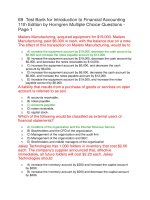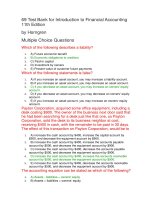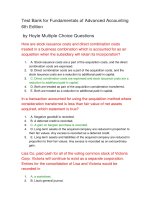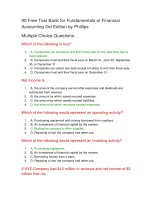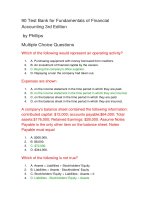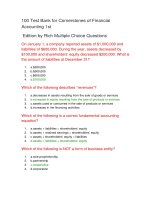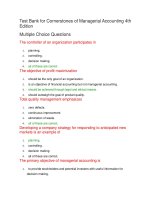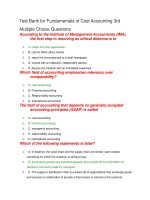127 test bank for fundamentals of financial accounting 4th edition by phillips
Bạn đang xem bản rút gọn của tài liệu. Xem và tải ngay bản đầy đủ của tài liệu tại đây (162.65 KB, 39 trang )
127 Test Bank for Fundamentals of Financial Accounting
4th Edition by Phillips
True- False Questions
Building a new warehouse is an operating activity.
1.
True
2.
False
Dividends are subtracted from revenues on the income statement.
1.
True
2.
False
A company owes $200,000 on a bank loan. It will be reported as Notes
Payable.
1.
True
2.
False
The payment of dividends is a financing activity.
1.
True
2.
False
In the United States, generally accepted accounting principles (GAAP) are
established by the PCAOB (Public Company Accounting Oversight Board).
1.
True
2.
False
All corporations acquire financing by issuing stock for sale on public stock
exchanges.
1.
True
2.
False
The stockholders' equity of a company is the difference between assets and
liabilities.
1.
True
2.
False
Contributed Capital is an asset on the balance sheet.
1.
True
2.
False
Daily activities involved in running a business such as buying supplies and
paying wages are operating activities.
1.
True
2.
False
The Securities and Exchange Commission (SEC) is the government agency
that has primary authority for setting accounting standards in the U.S.
1.
True
2.
False
Accounts payable, notes payable and wages payable are examples of
liabilities.
1.
True
2.
False
Amounts reported on financial statements are sometimes rounded to the
nearest million.
1.
True
2.
False
Revenue is reported on the income statement only if cash was received at the
point of sale.
1.
True
2.
False
Generally Accepted Accounting Standards require profitable companies to
distribute some of their profits to their stockholders.
1.
True
2.
False
You paid $10,000 to buy 1% of the stock in a corporation that has now gone
bankrupt. The company owes $10 million dollars to creditors. As a result of
the bankruptcy, you will lose $100,000.
1.
True
2.
False
If a company reports net income on the income statement, then the statement
of cash flows must show an increase in cash flows from operating activities
for the period.
1.
True
2.
False
Stockholders are creditors of a company.
1.
True
2.
False
A stock that does not pay a dividend is an undesirable investment.
1.
True
2.
False
The Sarbanes-Oxley Act (SOX) requires top management of companies to
sign a report certifying that the financial statements are free of error.
1.
True
2.
False
Creditors are mainly interested in the profitability of a company.
1.
True
2.
False
Mutiple Choice Questions- Page 1
The Publish or Perish Printing Company paid a dividend to stockholders. This
will be reported on the:
1.
A. audit report.
2.
B. income statement.
3.
C. balance sheet.
4.
D. statement of retained earnings.
If XYZ Company had $12 million in revenue and net income of $3 million, then
its:
1.
A. expenses must have been $15 million.
2.
B. expenses must have been $9 million.
3.
C. assets must have been $12 million.
4.
D. assets must have been $3 million.
The Don't Bite Me Pest Control Company has 10,000 gallons of insecticide
supplies on hand that cost $300,000; a bill from the vendor for $100,000 of
these supplies has not yet been paid. The company expects to earn $800,000
for its services when it uses the insecticide supplies. The company would
report a supplies asset in the amount of
1.
A. $10,000.
2.
B. $200,000.
3.
C. $300,000.
4.
D. $800,000.
During its first year of operations, Widgets Incorporated reported sales
revenue of $386,000 but collected only $303,000 from customers. The amount
to be reported as accounts receivable at the end of the year is
1.
A. $689,000.
2.
B. $386,000.
3.
C. $303,000.
4.
D. $83,000.
Accounting information systems:
1.
A. are summarized by reports that are published to the public.
2.
B. capture and report the results of a business's operating, investing, and financing
activities.
3.
C. monitor business activities only in financial terms.
4.
D. capture only the information that is needed by the owners of the company.
Public corporations:
1.
A. are businesses owned by two or more people, each of whom is personally liable for
the debts of the business.
2.
B. are businesses whose stock is bought and sold on a stock exchange.
3.
C. are businesses whose stock is bought and sold privately.
4.
D. are businesses where stock is not used as evidence of ownership.
Cash flow from investing activities includes
1.
A. amounts received from a company's stockholders for the sale of stock.
2.
B. amounts received from the sale of the company's office building.
3.
C. amounts paid for dividends to the company's stockholders.
4.
D. amounts paid for salaries of employees.
Creditors are:
1.
A. people or organizations who owe money to a business.
2.
B. people or organizations to whom a business owes money.
3.
C. stockholders of a business.
4.
D. customers of a business.
Dividends are reported on the:
1.
A. Income statement.
2.
B. Balance sheet.
3.
C. Statement of retained earnings.
4.
D. Income statement and balance sheet.
At the end of last year, the company's assets totaled $860,000 and its
liabilities totaled $740,000. During the current year, the company's total assets
increased by $58,000 and its total liabilities increased by $24,000. At the end
of the current year, stockholders' equity was
1.
A. $154,000.
2.
B. $120,000.
3.
C. $34,000.
4.
D. $178,000.
Which of the following is a true statement?
1.
A. The SEC approves the rules used by the auditors in determining whether a public
company's financial statements are in conformity with GAAP.
2.
B. The PCAOB and the SEC were both created by the FASB.
3.
C. The SEC was created by the PCAOB.
4.
D. The PCAOB approves the rules used by auditors in determining whether a public
company's financial statements are in conformity with GAAP.
Which of the following is true?
1.
A. Companies can choose to end their fiscal year on any date they feel is most
relevant.
2.
B. Companies must end their fiscal year on March 31, June 30, September 30, or
December 31.
3.
C. Companies can select any date except a holiday to end their fiscal year.
4.
D. Companies must end their fiscal year on December 31.
As of September 30, 2013, which source provided more financing for
Anonymous, Inc.?
1.
A. owners
2.
B. creditors
3.
C. both provided equal financing
4.
D. neither provided any financing
Which of the following would not represent a financing activity?
1.
A. Paying dividends to stockholders.
2.
B. An investment of capital by the owners.
3.
C. Borrowing money from a bank to purchase new equipment.
4.
D. Buying supplies on account.
Which one of the following statements regarding the balance sheet for
Anonymous Inc. is true?
1.
A. The $207,100 shown on the balance sheet has been distributed to stockholders as
dividends.
2.
B. Retained Earnings is misclassified. It should be reported as an Asset.
3.
C. Anonymous, Inc., is owed $310,500 from customers who have purchased goods or
services from the company, but have not yet paid for them.
4.
D. The retained earnings reported represents the retained earnings at the beginning of
the year.
Financing that individuals or institutions have provided to a company is
1.
A. always classified as liabilities.
2.
B. classified as liabilities when provided by creditors and stockholders' equity when
provided by owners.
3.
C. always classified as equity.
4.
D. classified as stockholders' equity when provided by creditors and liabilities when
provided by owners.
Operating activities:
1.
A. include interest paid on a bank loan.
2.
B. include the buying or selling of land, buildings, equipment, and other long-term
investments.
3.
C. include the repayment of loan proceeds to the bank.
4.
D. include a bank loan to cover the payment of wages, rent and other operating costs.
In which of the following organizational forms are the owners not taxed on the
business profits?
1.
A. Sole proprietorships.
2.
B. Partnerships.
3.
C. Corporations.
4.
D. Public partnerships.
The three main types of business activities measured by financial statements
are:
1.
A. selling goods, selling services, and obtaining financing.
2.
B. operating activities, investing activities, and financing activities.
3.
C. hiring, producing, and advertising.
4.
D. generating revenues, paying expenses, and paying dividends.
Net Income is
1.
A. the amount the company earned after expenses and dividends are subtracted from
revenue.
2.
B. the amount by which assets exceed expenses.
3.
C. the amount by which assets exceed liabilities.
4.
D. the amount by which revenues exceed expenses.
Expenses are shown
1.
A. on the income statement in the time period in which they are paid.
2.
B. on the income statement in the time period in which they are incurred.
3.
C. on the balance sheet in the time period in which they are paid.
4.
D. on the balance sheet in the time period in which they are incurred.
Which of the following would be reported on the income statement for 2013?
1.
A. Supplies that were purchased and used in 2012 but paid for in 2013.
2.
B. Dividends that were paid in 2013.
3.
C. Supplies that were purchased in 2012, but used in 2013.
4.
D. Accounts receivable as of December 31, 2013.
Which one of the following is not likely to be a consequence of fraudulent
financial reporting?
1.
A. The company's stock price drops once the fraud is discovered.
2.
B. Innocent accountants who work for the company's CPA firm lose their jobs.
3.
C. Creditors recover 100% of amounts owed to them.
4.
D. Employees lose their retirement savings.
Which of the following is not true?
1.
A. Assets = Liabilities + Stockholders' Equity
2.
B. Liabilities = Assets - Stockholders' Equity
3.
C. Stockholders' Equity + Liabilities - Assets = 0
4.
D. Liabilities - Stockholders' Equity = Assets
Which of the following are the three basic elements of the balance sheet?
1.
A. assets, liabilities, and retained earnings.
2.
B. assets, liabilities, and contributed capital.
3.
C. assets, liabilities, and revenues.
4.
D. assets, liabilities, and stockholders' equity.
A company's balance sheet contained the following information:Contributed
Capital: $12,000; Accounts Payable: $64,000; Total Assets: $176,000; Retained
Earnings: $28,000. Assume Notes Payable is the only other item on the
balance sheet. Notes Payable must equal
1.
A. $200,000.
2.
B. $8,000.
3.
C. $72,000.
4.
D. $344,000.
The Whackem-Smackem Software Company sold $11 million of computer
games in its first year of operations. The company received payments of $7.5
million for these computer games. The company's income statement would
report:
1.
A. sales revenue of $7.5 million.
2.
B. accounts receivable of $3.5 million.
3.
C. expenses of $3.5 million.
4.
D. sales revenue of $11 million.
Which of the following would not affect a company's net income?
1.
A. A change in the company's income taxes.
2.
B. Changing the selling price of a company's product.
3.
C. Paying a dividend to stockholders.
4.
D. Advertising a new product.
The separate entity assumption means:
1.
A. a company's financial statements reflect only the business activities of that
company.
2.
B. each separate owner's finances must be revealed in the financial statements.
3.
C. each separate entity that has a claim on a company's assets must be shown in the
financial statements.
4.
D. if the business is a sole proprietorship, the owners' personal activities are included
in the company's financial statements.
Which of the following is not a professional certification for accountants?
1.
A. CFO
2.
B. CPA
3.
C. CMA
4.
D. CIA
Public accountants:
1.
A. provide services to a variety of businesses.
2.
B. may work for the SEC.
3.
C. are government employees.
4.
D. are generally involved in internal auditing, budgeting, and cost accounting.
Financial statements are most commonly prepared:
1.
A. daily.
2.
B. monthly, quarterly and annually.
3.
C. as needed.
4.
D. weekly.
Assets:
1.
A. represent the amounts earned by a company.
2.
B. must equal the liabilities of a company.
3.
C. must equal the stockholders' equity of the company.
4.
D. represent the resources owned by a company.
107 Free Test Bank for Fundamentals of Financial
Accounting 4th Edition by Phillips Mutiple Choice
Questions- Page 2
What would a financial statement user learn from reading the auditors'
report?
1.
A. Whether the financial statements present a fair picture of the company's financial
results and are prepared in accordance with GAAP.
2.
B. Whether or not it is a good time to purchase the stock.
3.
C. How much the company plans to distribute as dividends.
4.
D. Whether or not the company has plans for future expansion.
Investors and creditors look at the balance sheet to see whether the
company:
1.
A. is profitable.
2.
B. owns enough assets to pay what it owes to creditors.
3.
C. has had a positive cash flow from operations.
4.
D. is paying sufficient dividends to stockholders.
Internal users of financial data include:
1.
A. investors.
2.
B. creditors.
3.
C. management.
4.
D. regulatory authorities.
Which inference may be considered incorrect concerning the Statement of
Retained Earnings?Hooper's Hops: state of retained earnings for the year
ended december 31, 2013: retained earnings, january 1, 2013: $167,800; Net
income for 2013: $219,100; dividends for 2013:(36,400); retained earnings,
december 31,2013: $350,500.
1.
A. Retained earnings of $350,500 will appear on the balance sheet as of December 31,
2013.
2.
B. The net income in the above statement came from the income statement for the
year ending December 31, 2013.
3.
C. Dividends are shown in parentheses because they are distributions made by a
company to its stockholders as a return on their investment.
4.
D. Retained earnings represents the amount of cash at the end of 2013.
Investors are often interested in the amount of net income distributed as
dividends. In which section of the financial statements would investors look
to find this amount?
1.
A. Statement of retained earnings.
2.
B. Balance sheet.
3.
C. Notes to the financial statements.
4.
D. Income statement.
Which of the following statements is true?
1.
A. The "net change in cash" reported on the statement of cash flows is also reported
on the statement of retained earnings.
2.
B. Both the income statement and the statement of cash flows show the result of a
company's operating activities.
3.
C. The statement of cash flows is for a period of time while the income statement is at
a point in time.
4.
D. The statement of cash flows is at a point of time while the income statement is for a
period of time.
A creditor might look at a company's financial statements to determine if the:
1.
A. company is likely to have the resources to repay its debts.
2.
B. company's stock is likely to fall, signaling a good time to sell.
3.
C. company's stock is likely to rise, signaling a good time to buy.
4.
D. company pays a dividend.
Every financial statement should have "who, what, and when" in its heading.
These are:
1.
A. the name of the person preparing the statement, the type of financial statement, and
when the financial statement was reported to the SEC.
2.
B. the name of the person preparing the statement, the name of the company, and the
date the statement was prepared.
3.
C. the name of the company, the type of financial statement, and the time period or
date from which the data were taken.
4.
D. the name of the company, the purpose of the statement, and when the financial
statement was reported to the IRS.
Which of the following business organizations has only one owner?
1.
A. A corporation.
2.
B. A sole proprietorship.
3.
C. A public company.
4.
D. A partnership.
In the U.S., public companies have to be audited by independent auditors
using rules approved by the:
1.
A. 1933 Securities Act.
2.
B. Public Company Accounting Oversight Board (PCAOB).
3.
C. Financial Accounting Standards Board (FASB).
4.
D. American Institute of Certified Public Accountants (AICPA).
An investor might look at a company's financial statements to determine all of
the following, except:
1.
A. if the company's earnings are rising or falling.
2.
B. if the company pays a dividend.
3.
C. if the company has positive cash flow.
4.
D. if the company's owners are financially sound.
Which of the following actions would be considered unethical?
1.
A. A company does not distribute any of its profits to stockholders.
2.
B. A company rounds the revenues and expenses that it reports on the income
statement.
3.
C. An unintentional mistake made by a new accountant.
4.
D. The cousin of one of the business owners is hired to perform the annual audit.
A company's quarterly income statements show that in the last three quarters
both sales revenue and net income have been falling. Which of the following
conclusions drawn by users are valid, given this information?
1.
A. Creditors are likely to conclude that the risk of lending to the company is falling and
might be willing to accept a lower interest rate on loans.
2.
B. Investors are likely to conclude that the stock price is likely to rise, making the
company more attractive as a potential investment.
3.
C. Customers are likely to conclude that the company is struggling, therefore it is
permissible to take longer to pay amounts they owe to the company.
4.
D. Owners may conclude that the company will be less likely to distribute dividends.
During 2013, a company's assets increase by $56,000 and its liabilities
increase by $38,000. If no dividend is paid and no further capital is
contributed, net income for 2013 was:
1.
A. $56,000.
2.
B. $18,000.
3.
C. $94,000.
4.
D. $38,000.
Which of the following is not a difference between notes payable and
accounts payable?
1.
A. Notes payable are not interest free while accounts payable may be interest free.
2.
B. Notes payable are often outstanding for longer periods of time than accounts
payable.
3.
C. Notes payable are documented using formal written debt contracts while accounts
payable are generally informal.
4.
D. Notes payable are reported as stockholders' equity on the balance sheet while
accounts payable are reported as liabilities on the balance sheet.
In the U.S., generally accepted accounting principles are established:
1.
A. directly by the 1933 Securities Act.
2.
B. by the Public Company Accounting Oversight Board (PCAOB).
3.
C. by the Financial Accounting Standards Board (FASB).
4.
D. by the American Institute of Certified Public Accountants (AICPA).
Which of the following is true about the format of financial statements?
1.
A. A double underline is drawn below the subtotal for total liabilities on the balance
sheet.
2.
B. Dollar signs are omitted if the heading states that amounts are reported in U.S.
dollars.
3.
C. Dividends are reported in parentheses on the statement of retained earnings.
4.
D. The heading of each financial statement indicates who, when, and what in that
particular order.
The purpose of a statement of retained earnings is to:
1.
A. estimate the current value of a company's assets.
2.
B. report how the profits of a company have been distributed to stockholders or
retained in the business.
3.
C. show where the cash is flowing into and out of a company.
4.
D. explain the specific revenues and expenses arising during the period.
Which of the following is not an expense?
1.
A. Wages of employees.
2.
B. Interest incurred on a loan the company had taken out.
3.
C. Dividends.
4.
D. Corporate income tax.
The WC Company borrowed $26,500 from a bank during 2013.
1.
A. This would be listed as ($26,500) under investing activities on the statement of cash
flows.
2.
B. This would be listed as ($26,500) under operating activities on the statement of cash
flows.
3.
C. This would be listed as $26,500 under investing activities on the statement of cash
flows.
4.
D. This would be listed as $26,500 under financing activities on the statement of cash
flows.
Which of the following would be acceptable as an alternative term used for the
income statement?
1.
A. Statement of Operations.
2.
B. Statement of Financial Position.
3.
C. Statement of Retained Earnings.
4.
D. Statement of Revenues and Expenses.
Which of the following is true regarding a company's fiscal year?
1.
A. All companies have a December 31 year end.
2.
B. It usually corresponds to a company's slow period.
3.
C. It always corresponds to the calendar year.
4.
D. The Financial Accounting Standards Board assigns a year end to each company.
107 Free Test Bank for Fundamentals of Financial
Accounting 4th Edition by Phillips Mutiple Choice
Questions- Page 3
A company's financial records at the end of the year were as follows:Cash:
$70,000; Accounts receivable: 28,000; Supplies: 4,000; Accounts payable:
10,000; notes payable: 5,000; retained earnings, begining of period: 17,000;
contributed capital:40,000; service revenue: 53,000; wages expense: 8,000;
advertising eapense: 5,000; rent expense: 10,000. What is the amount of total
assets to be reported on the balance sheet at the end of the year?
1.
A. $112,000
2.
B. $102,000
3.
C. $119,000
4.
D. $155,000
Generally accepted accounting principles (GAAP) were (are) established by:
1.
A. an Italian monk in 1494.
2.
B. the U.S. Congress in 1933.
3.
C. the PCAOB in 2004.
4.
D. the FASB on an ongoing basis.
The statement of cash flows for a company contained the following:Cash
flows from operating activities: $ 29,000; Cash flows from investing activities:
$ ($30,000); Cash flows from financing activities: $ ($45.000). What was the
change in cash for the period?
1.
A. $14,000 increase
2.
B. $15,000 increase
3.
C. $14,000 decrease
4.
D. $15,000 decrease
For the current year, the first year of operations, a company sold $100,000 of
goods to customers and received $90,000 in cash from customers. The
remainder is owed to the company at the end of the year. The company
incurred $70,000 in expenses for the year and paid $65,000 of these in cash.
The remainder is owed by the company at the end of the year. Based on this
information, what is the amount of net income for the year?
1.
A. $25,000
2.
B. $35,000
3.
C. $20,000
4.
D. $30,000
According to Generally Accepted Accounting Principles, which of the
following is not a characteristic of useful financial information?
1.
A. comparable.
2.
B. verifiable.
3.
C. timely.
4.
D. ethical.
cash inflow from customers: $10,000; cash outflow from purchase of
equipment: $ 40,000; cash inflow from capital contributed by stockholders:
$30,000; cash outflow from payments to suppliers & employees: 5,000; cash
outflow from payment of dividends to stockholders: $1,000; cash inflow from
borrowing from the bank: $20,000. The amount of beginning retained earnings
is equal to which of the following?
1.
A. The beginning retained earnings of the prior year.
2.
B. The ending retained earnings of the prior year.
3.
C. The beginning retained earnings of the next year.
4.
D. The ending retained earnings of the next year.
The amount of retained earnings at the end of the year is
1.
A. $15,000.
2.
B. $11,000.
3.
C. $12,000.
4.
D. $1,000.
Faithful representation is a characteristic of external financial reporting that
means
1.
A. the financial reports of a business are assumed to include the results of only that
business's activities.
2.
B. financial information can be compared across businesses because similar
accounting methods are applied.
3.
C. the results of business activities are reported using an appropriate monetary unit.
4.
D. financial information depicts the economic substance of business activities.
Which of the following statements is false?
1.
A. When choosing between a company that pays steady dividends and one that retains
its earnings to support future growth, investors will always choose the company that
pays steady dividends.
2.
B. Companies can develop reputations for honest financial reporting even when
conveying bad news.
3.
C. Trends in a company's net income from year to year can provide clues about its
future earnings, which can help investors to decide whether to buy stock in the
company.
4.
D. Information in the notes to the financial statements can influence a user's
interpretation of balance sheet and income statement information.
The amount of assets at the end of the year is
1.
A. $105,000.
2.
B. $108,000.
3.
C. $104,000.
4.
D. $107,000.
Which of the following statements is true regarding accounting standards
used in other countries?
1.
A. U.S. GAAP is used worldwide.
2.
B. IFRS are used by all countries.
